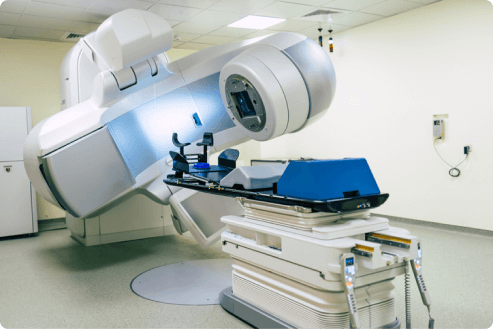Image Guided Radiation Therapy (IGRT)
Sophisticated imaging techniques allow radiologists to administer higher doses of radiation to a tumor without increasing the risk of toxicity for the patient. Image-guided radiation ensures better coverage of the tumor and less collateral damage to healthy tissue.

What Is Image Guided Radiation Therapy?
Image-guided radiation therapy is a type of cancer treatment that uses precise imaging to target beams of high-energy radiation. Mesothelioma specialists often use IGRT as a type of external beam radiation in aggressive treatment plans. However, oncologists find it challenging to administer radiation to mesothelioma patients safely.
Mesothelioma tumors form close to sensitive vital organs such as the lungs, heart, liver, intestines and kidneys. The tumors may also move when the patient breathes or their abdominal organs shift because of digestion. IGRT improves the accuracy of radiation delivery so healthy tissue isn’t damaged.
Radiation oncologists must make a trade-off between treatment effectiveness and safety. A higher dose of radiation will kill more cancer cells, but it could also cause severe complications if it accidentally hits healthy cells.
Modern technologies such as intensity-modulated radiation therapy and proton therapy can target areas in the body much more selectively. Even so, these therapy techniques are only as good as the imaging scans that guide them, and this is where the emerging methods of IGRT come in.
- Image-guided radiation therapy is a standard and approved form of mesothelioma treatment. It is a type of external radiation that uses highly accurate images to direct high-energy radiation beams at tumors.
- Because of its accuracy, doctors can use higher doses of radiation to target mesothelioma tumors without damaging healthy tissues and organs.
- 4D-imaging accounts for the motion of the tumor site as the patient breathes, tracking the tumor and avoiding healthy tissue with each breath.
- Doctors may use IGRT alone or in combination with chemotherapy, surgery or immunotherapy depending on a patient’s suitability for each treatment. These combinations are also under investigation in clinical trials.
Image-Guided Radiation Therapy for Mesothelioma
IGRT for mesothelioma involves performing imaging scans immediately before or during every radiation therapy session. This way, the radiologist can adjust the treatment if the tumor site’s position changes or the patient has lost or gained weight.
These types of combination devices have become more common in the past decade. And many experts expect the average IGRT session duration to shorten as technology improves. However, in many cases, cancer patients still receive imaging scans and radiation therapy on different days and in other facilities. Research has shown this isn’t ideal.
- High cost of the technology
- Significant level of experience required to use it
- Therapy sessions take longer (40 minutes vs. 20)
Lung cancer presents many of the same targeting problems as pleural mesothelioma. A study of 91 patients with lung cancer revealed daily imaging scans during radiation therapy were associated with a longer median survival time than weekly imaging scans.
As with all types of cancer treatment, the best hope for mesothelioma patients is to go to one of the top cancer centers in the country. Remember, only an experienced mesothelioma specialist can determine whether any radiation therapy is appropriate. Mesothelioma is a rare and complex form of cancer. Every case requires an individualized treatment plan.
4D-Imaging Use in IGRT
Even when a doctor performs an imaging scan before radiation treatment, the static scan might not account for the tumor site’s motion and the body’s vital organs. Specialists developed four-dimensional imaging to address this problem.
In 4D imaging, the fourth dimension is time. This property allows doctors to track the cyclical path of the tumor site’s position in the body as the patient breathes.
You could think of this as a 3D video of the inside of the chest that plays on a loop. It shows doctors how organs move when the patient inhales and exhales.
A radiologist could use 4D imaging to ensure the most intense radiation stays confined to the tumor site. Or they could synchronize the aim of the radiation machine to the motion of the target in the body.

History of IGRT
A 2021 research paper in the World Journal of Clinical Oncology stated IGRT allows for the use of more precise treatments. The authors noted IGRT also enables the delivery of “potentially curative doses” to tumors while “maintaining doses to surrounding healthy tissue at an acceptable level.”
Siemens in 2000 unveiled a computed tomography scanner that hospitals could install alongside a linear accelerator in the same room. This advancement made it possible to take a CT scan and administer radiation without moving the patient.
Two years later, Accuray introduced the TomoTherapy System, a single machine that can perform CT scans and administer intensity-modulated radiation therapy. In 2015, doctors hailed the development of the first combination of linear accelerator and magnetic resonance imaging machines.
Recommended Reading


